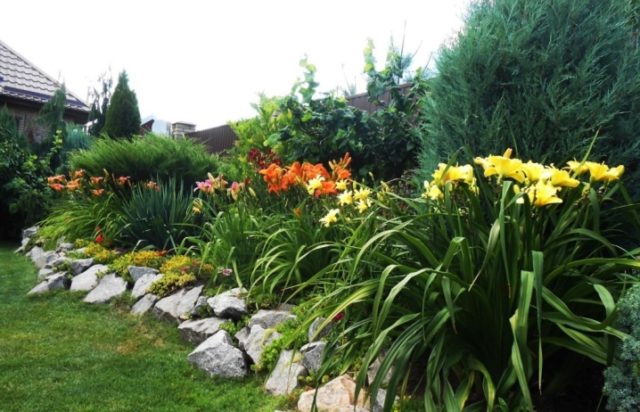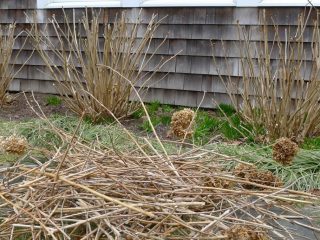Content
- 1 Features of using daylilies in garden landscape design
- 2 What varieties of daylilies are used in garden landscape design?
- 3 Types of compositions with daylilies in landscape design
- 4 What colors do daylilies go with?
- 5 Caring for daylilies in landscape design
- 6 Photo of daylilies in garden landscape design
- 7 Conclusion
Daylilies in the landscape design of a summer cottage, garden, even a small vegetable garden are at the peak of popularity among modern gardeners. When most plants finish blooming in the spring, these varieties provide a wide variety of colors and shapes throughout the summer season. It is also important that the plants are unpretentious in care, winter well and withstand the sun in mid-summer. A skillful combination of daylilies with other plants will make the site unforgettably beautiful.

Bright and juicy flowers will decorate any landscape
Features of using daylilies in garden landscape design
Daylily, or Krasodnev, is a beautiful, herbaceous plant that does not require complex manipulations in care. It is considered decorative and is widely used in landscaping and design of gardens, personal plots, and public places. Different types of plants grow independently in the wild, mainly in the Far East - China, Korea, Japan.Daylilies have been able to adapt to the conditions of the Russian climate; wild species grow in the southern regions of Siberia to the upper reaches of the Ob River in the west.
It has good resistance to disease and harsh weather conditions. It grows in shade, partial shade, and in the sun its flowering is most abundant. Requires at least 6 hours of exposure to the rays per day.
Daylily is a perennial herbaceous plant. Among all the varieties, only one is evergreen - Hemerocallis aurantiaca. The roots are cord-like, thickened, and sometimes form short-lived shoots. Wide-linear foliage is arranged in two rows, depending on the variety - straight or curved into an arc. Bright large flowers are the main feature of daylily. The color range is from yellow to reddish brown. The shape is funnel-shaped, with six petals. Arranged in inflorescences of 2 to 10 flowers.
Peduncles reach 1 m in height. For decorative purposes, they are conventionally divided into low specimens (up to 30 cm), medium (30-60 cm), semi-high (60-90 cm) and high (more than 90 cm). Fruits in triangular capsules with a small number of seeds.
What varieties of daylilies are used in garden landscape design?
There are many varieties of daylily, each of which has characteristics of appearance, flowering time, etc. Among them are:
- terry - decorative, characterized by splendor;
- multiforms - a combination of several unique characteristics in one variety;
- ordinary daylilies - more similar to the wild varieties that can be found in nature;
- original – having a non-standard color, unusual shape;
- arachnids - petals of a special shape, more reminiscent of long spider legs.
The most common varieties:
- Brown-yellow is one of the most unusual specimens in terms of color among daylilies. It is considered a terry variety. It blooms in mid-summer, feels good in partial shade, and in the foreground in group compositions.
The brown-yellow variety has rich colors
- Yellow daylily. It is most famous among landscape designers. The plant reaches 1 m in height. Blooms from early July until autumn. It has a pleasant sweet aroma that attracts bees. It is noteworthy that it steadfastly tolerates excess moisture in the soil, which gardeners take advantage of and plant the bush in lowlands, decorating the waterways of gardens.
The variety is one of the most sought after by phyto-designers
- Lemon yellow. It differs in that the stem grows more than 1 m (about 130 cm) in height. It blooms in mid-summer and withstands drought and heat. Among the positive qualities of this daylily variety is its pleasant aroma.
Lemon yellow variety - a good choice for high-altitude compositions
- Middendorf. A short daylily that blooms earlier than other varieties. The yellow buds are more reminiscent of a golden color. Exudes a subtle pleasant aroma.
Variety Middendorf - real natural gold in the garden
- Night Bacon. A particularly decorative variety due to its deep purple hue with a bright yellow core. Large bud, reaches 8 cm in diameter, terry. Separately, high resistance to direct sunlight is noted - the plant does not fade.
The Night Bacon variety is exceptional among others due to its amazing color
Types of compositions with daylilies in landscape design
Daylilies look harmonious in any landscape and combine well with other plants. And the right location and composition will help create a true work of art. Tapeworms (single plantings) and mixed “mixborders” are planted approximately according to the following schemes:
- Low varieties are planted on alpine hills and rocky places.
- Daylilies are used to create hedges along borders, fences and fences.
- Individual compositions are installed in the middle of clearings, on lawns and ridges.
- Decorate patios, on the sides of steps, and terraces with pots, tubs and containers.
- Given the pleasant aroma emanating from flowering plants, they are often grown near benches and around gazebos.
Low daylilies are planted singly along paths. Compositions of different plant varieties are planted along the alleys, with tall representatives of the flora in the background and miniature bushes in front. Daylilies and hostas are noted in landscape design, when the former have large bright buds that contrast with the shrubs.

Daylilies and hostas look great in contrasting colors
Having a daylily variety with a round or star-shaped bud, it is planted in a group with pyramidal or spherical flowers, for example, different types of hydrangea.
There are types of daylilies that have a greenish core, which is often used by gardeners in a combination of bright and contrasting shades of flowers of other representatives of the fauna.

When the daylily has a yellow core, it can be easily combined with hostas of the same color
Red daylilies are planted mainly with yellow tones of other flowers.

Dark varieties are harmonious with light fauna

It is better to calm down bright and variegated shades with soft colors, coniferous, warm tones
If you exclude the use of other flowers and shrubs, daylilies combine well with each other or in a single composition.

You can choose the color scheme wisely, for example, a single color, but in different shades
The dominant color is chosen to be the one that has a lighter shade and is placed in the center. Around it it is decorated with slightly darker flowers and, moving away from the middle, the colors become darker and more saturated.
You can use a multi-layer effect when dense tall bushes are planted in the background, medium-sized bushes in front of them, and so on lower. The color of the buds can be monochromatic or in many shades.

Miniature bright daylilies will look great near rocky structures, as well as alpine hills
And if there is a stream, pond, or artificial waterfall on the site, then there are special varieties of daylilies that tolerate excess moisture well. In addition, near a pond they will have a special harmony with lilies, phlox, and astilbes.
What colors do daylilies go with?
A good option would be to combine flowers with the following types of plants:
- Agapanthus. This faunal union is considered quite unusual, given the bright colors of different varieties of both plants. It is worth choosing the right shades, for example, giving preference to warm or dark daylilies. A fresh and bright composition can be made from agapanthus and daylily in yellow, orange or brown colors.
A composition with agapanthus is like a rainbow in the garden
- Irises and daylilies require special attention in landscape design. They are combined not only in color, but also in the flowering period, which makes this pair an excellent option for decorating a site. Both begin to bloom in June, finally fading by the end of August.
Composition with irises - fauna that complements each other
- Phloxes. Daylilies in combination with this plant are grown in summer cottages and gardens. The lilac, pink and white tones of phlox are preferred. The important thing is that they bloom at the same time, so this composition is considered very successful.
A composition with phlox will look delicate
Caring for daylilies in landscape design
Before planting daylilies, you need to know a number of minor rules and conditions for their maintenance. It is worth remembering that only some varieties bloom well in direct sunlight, while most should be provided with partial shade. Almost any soil is suitable for them, even with an acidic reaction. It is possible to use liming, which will make the soil suitable for further development of the flower. After the daylily has faded, the plant is fed with sulfate at the end of summer. Watering is done by “sprinkling” throughout the night, i.e. an irrigation system is required.
Daylily is propagated by dividing the bush, preferably in early spring or autumn. In order for the plant to adapt faster, you need to remove all the foliage. When planting, the pit is fertilized with potassium sulfate; no further replanting is required.
Therefore, it is worth carefully planning possible compositions, colors and combinations with other plants in advance.It is worth considering what plan to plant the daylily on, what place it will occupy in group seedlings, because this moment has its own rules.
Photo of daylilies in garden landscape design
To have an idea of how certain compositions look and to get inspired by ideas, you can first study their images in photographs:
- Plants are chosen to fill the area with lush green flowers and vibrant flower colors. Daylilies go well with the simplest decorative flowers.
A composition with different bright fauna will delight the eye
- Particular mention is made of daylily compositions in rocky gardens. Vibrant fauna brings the stone walls and masonry to life, leaving room for a unique view.
A composition near a rocky garden will make him inspired
- It is noteworthy that this plant does not need other species at all. You can decorate a garden or an entire lawn with daylilies of different varieties, which implies a riot of colors, different sizes and gradual flowering.
An arrangement of different varieties of daylilies shows that they do not need other flowers.
- Daylilies grow not only on wide ground, but can also bloom in large pots, tubs, containers, while feeling comfortable.
Daylilies are so unpretentious that they even grow in a tub
- Some varieties calmly tolerate excess moisture, so they decorate places near reservoirs, ponds, and streams. The photo below shows a composition of daylily, fragrant lavender and juniper.
The composition near the pond is extremely beautiful, the daylily is the central element here
- It is worth paying more attention to the daylily near the pond. Especially in combination with larch, willow, juniper, lavender, sedum, gray Victoria and hydrangeas.
Daylilies will not deteriorate near the pond because they are resistant to excess moisture
- It has been noted more than once that daylilies are tolerant of direct sunlight, and some varieties are able to withstand the hottest weather.
Some varieties grow well along the road even in bright sun
Conclusion
Daylilies in the landscape design of a summer cottage are an easy choice even for novice phyto-designers. By using the simple rules of planting a plant and skillfully combining it with others, you can create an unusually beautiful landscape that will be renewed from year to year.























